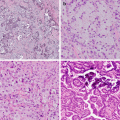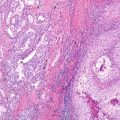© Springer International Publishing AG 2018
Philip T. Cagle, Timothy Craig Allen, Mary Beth Beasley, Lucian R. Chirieac, Sanja Dacic, Alain C. Borczuk, Keith M. Kerr, Lynette M. Sholl, Bryce Portier and Eric H. Bernicker (eds.)Precision Molecular Pathology of Lung CancerMolecular Pathology Libraryhttps://doi.org/10.1007/978-3-319-62941-4_1414. Molecular Pathology of Small Cell Carcinoma
(1)
Mount Sinai Medical Center, New York, NY, USA
Keywords
Small cell carcinomaMolecularRbTP53NeuroendocrineIntroduction
Small cell carcinoma (SCLC ) comprises approximately 15% of all lung carcinomas, although the incidence has reportedly declined in recent years [1]. SCLC has traditionally been regarded as distinct from “non-small cell carcinomas (NSCLC) ” (i.e., adenocarcinoma, squamous cell carcinoma, and undifferentiated large cell carcinoma), in large part due to the traditional treatment of SCLC with chemotherapy in contrast to surgery. However, more recent literature supports that surgery may produce a survival benefit in low-stage disease [2, 3]. SCLC, along with large-cell neuroendocrine carcinoma (LCNEC) , is high-grade neuroendocrine carcinoma with a poor prognosis. While SCLC and LCNEC are often considered as one end of a spectrum of pulmonary neuroendocrine carcinomas including the low-grade typical carcinoid (TC) and the intermediate-grade atypical carcinoid (AC), recent studies have shown distinct differences in clinical, immunohistochemical, and molecular features of the high-grade tumors and TC/AC , challenging the concept that these represent a spectrum of tumors arising from a common precursor cell [4, 5].
Molecular Analysis of Small Cell Carcinoma
SCLC harbors many of the common genetic alterations found in other carcinomas; however, as would be expected, the frequency of their occurrence differs, and SCLC additionally harbors mutations not typically found in other lung carcinomas.
In general, SCLC typically shows a very high frequency of p53 mutations and Rb inactivation . Rb inactivation is found in 80–100% of SCLC, and, due to their inverse relationship, loss of p16INK4 is infrequently encountered. As would be expected, Rb loss leads to overexpression of E2F and loss of cell cycle arrest. The finding of a high level of Rb inactivation in SCLC is different from non-small cell carcinomas, which tend to have lower levels of Rb loss and higher levels of p16 loss or cyclin D1 overexpression [6–8]. While a precise precursor lesion for SCLC has not been identified, it has been suggested that Rb inactivation occurs as an early event, followed by LOH mutation of 5q and/or 22q followed by C-MYC amplification [9].
In contrast to the carcinoid tumors, SCLC has a higher frequency of deletions on chromosomes 3p and 17p and has an inverted bcl-2/Bax ratio [7, 10]. SCLC also has a higher level of telomerase activity [11]. TERT copy gain has more recently been shown to be an independent predictor of poor prognosis [12]. Loss of heterozygosity (LOH) for 3p, 5q21, and 9p has also been found [7, 8]. Mutations of the MEN1 gene, as seen in TC and AC, are not seen in SCLC [13]. In regard to gene copy number specifically, SCLC has been found to have fairly consistent increased copy number on chromosomes 1, 3q, 5p, 6p, 12, 14, 17q, 18, 19, and 20 while showing copy number loss on 3p, 4, 5q, 10, 13, 16q, and 17p [14–16]. In an array-based study, Voortman et al. demonstrated copy number gains in at least 1 MYC family member in 27/33 SCLCs but in only 1/19 carcinoids. This study also demonstrated copy number increases in the fibroblast growth factor receptor 1 (FGFR1) gene and for the Janus kinase 2 (JAK2) gene in one SCLC case each but in no carcinoid tumors [17].
More recently, studies have examined the genomic profile of SCLC with more extensive profiling techniques [18–21]. Comprehensive genomic profiling of 110 SCLCs using whole-genome sequencing was reported by George et al. [18]. This analysis confirmed previously known genomic losses in 3p, particularly 3p14.3-3p14.2 and 3p12.3-3p12.2 harboring FHIT and ROBO1, respectively. This study also confirmed that nearly all SCLC harbored bi-allelic inactivation of TP53 and RB1. Interestingly, the two cases which harbored a wild-type RB1 were found to have abnormalities leading to overexpression of cyclin D1, thus providing an alternate pathway for Rb inactivation. The authors concluded that complete genomic loss of both TP53 and RB1 was obligatory in the pathogenesis of SCLC [18].
Another interesting finding in this study was that mutations affecting the NOTCH family genes were found in 25% of SCLC. Additionally, the majority of cases demonstrated high levels of DLK1, an inhibitor of Notch signaling , while a second subset of tumors instead expressed ASCL1. ASCL1 is a lineage oncogene of neuroendocrine cells, the expression of which is inhibited by active Notch signaling. As such, both patterns suggest low Notch pathway activity in SCLC. Expanded studies in mouse models suggest activated Notch signaling may serve as a tumor suppressor in SCLC [18]. Interestingly, mutations in NOTCH family genes appeared to be mutually exclusive from mutations in CREBBP, EP300, TP73, RBL1, and RBL2 which have also been reported in other studies in addition to mutations in PTEN and PIK3CA [18, 22].
As would be expected, the two high-grade neuroendocrine carcinomas, SCLC and LCNEC , have many similarities from a molecular standpoint. Indeed, Jones et al. demonstrated that SCLC and LCNEC were indistinguishable by gene profiling analysis [23]. However, differences between the two tumors have been demonstrated. An extensive array-based study by Peng et al. [24] demonstrated a large number of common mutations but also noted some statistically significant differences, specifically that losses at 3p26-22, 4q21, 4q24, and 4q31 were seen more frequently in SCLC, while gains at 2q31, 2q32, and 2q33 along with loss at 6p21.3 were associated with LCNEC. A study by Hiroshima et al. [25] reported a statistically significant difference in allelic loss of 5q33 between SCLC and LCNEC. Both LCNEC and SCLC show high expression of hASH1 which is involved in neuroendocrine differentiation; however, a study by Nasgashio et al. [26] demonstrated that while both tumors showed high expression levels of hASH1 mRNA, the staining score of hASH1 was higher in SCLC. Additionally, this study also found that expression of hairy/enhancer of split 1 (HES1), a negative regulator of neuroendocrine differentiation, was more highly expressed in LCNEC, suggesting that SCLC more strongly expressed a neuroendocrine phenotype, while LCNEC retained characteristics more similar to bronchial epithelium [26].
It is known that LCNEC and SCLC may be combined with one another, and an elegant study by D’Adda et al. [27] was the first to study genetic alterations in combined SCLC/LCNEC using microdissection to evaluate the components separately and compared the results with pure SCLC or LCNEC. In this study, six combined SCLC/LCNEC were compared with eight pure SCLC and eight pure LCNEC. In the combined tumors, both components demonstrated a common pattern of genetic alterations involving 17p13.1, 3p14.2-3p21.2, 5q21, and 9p21. The authors note that these alterations are usually involved in early carcinogenesis and therefore suggest a close relationship between the two components and further hypothesize they may be evidence of a monoclonal carcinogenesis mechanism. The authors did find differences between the two components. The LCNEC component had more frequent alterations in 6q, 10q, and 16q, while alterations in the 6p and X-Y PAR regions were seen more frequently in the small cell component, although none reached statistical significance. Interestingly, alterations were reported in both components of the combined tumors which have not been highly reported in either tumor in pure form, implying that the two components of the combined tumors potentially have more commonality with each other than they have due to their respective pure forms. The authors conclude that combined SCLC/LCNEC represent “transition” carcinomas in the spectrum of high-grade neuroendocrine pulmonary tumors, with pure forms representing the two extremes of this differentiation [27]. Buys et al., in contrast, reported a combined SCLC, LCNEC, and adenocarcinoma and evaluated the genomic profiles of each tumor component. In this study they failed to find shared genetic alterations between the SCLC and LCNEC components and suggested the two components evolved independently, as did the adenocarcinoma component [28].
Molecular Abnormalities in Small Cell Carcinoma in Relation to Targeted Therapy
In regard to SCLC and potential targeted therapies, SCLC has not been shown to harbor EGFR mutations, and there is currently no evidence to support that EGFR tyrosine kinase inhibitors have a role in the treatment of SCLC outside of isolated case reports [29, 22, 30]. However, Voortman et al. did demonstrate that SCLC harbored copy number alterations in genes encoding proteins in the PI3K-AKT pathway and apoptosis pathway genes such as BCL- 2, MCL1, and PMAIP1, suggesting these may be potential drug targets [17]. Abnormalities in the PI3K/AKT/mTOR pathway have been reported by multiple authors, and it has been observed that deletion of PTEN, which acts as a suppressor of this pathway, may be an important driver of SCLC [21, 22, 31]. Studies evaluating everolimus and temsirolimus , inhibitors of mTORC1, in SCLC have thus far demonstrated only limited antitumor activity, and evaluation of drugs directed toward other pathway targets is needed [22, 31].
Stay updated, free articles. Join our Telegram channel

Full access? Get Clinical Tree





